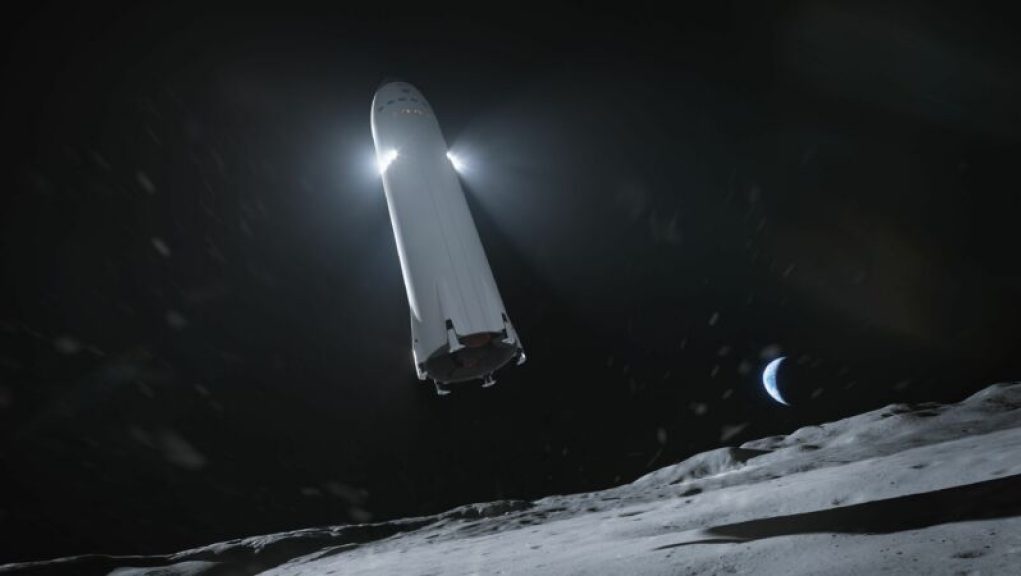Hold on to your space helmets, folks! NASA just awarded a $3.4 billion contract to Blue Origin for the design and construction of a second Human Landing System to fly astronauts down to the Moon. This is a huge win for Blue Origin owner Jeff Bezos, who has been lobbying for this coveted piece of NASA’s Artemis program for the past two years.
But the real story here is the revolutionary approach that Blue Origin took to win this contract. After losing the initial lander contract to SpaceX two years ago, Blue Origin didn’t just bid a lower price this time around. Instead, they completely transformed the means by which they would put humans on the Moon. The Blue Moon lander is now completely reusable, and will remain in lunar orbit, going up and down to the surface. It will be serviced by a transport vehicle that will be fueled in low-Earth orbit and then deliver propellant to the Moon. This transporter, in turn, will be refilled by multiple launches of the reusable New Glenn rocket.
This is a game-changer in the world of space exploration. With SpaceX’s fully reusable Starship and now Blue Moon, NASA has selected two vehicles based around the concept of many launches and the capability to store and transfer propellant in space. This is potentially the biggest change in spaceflight since the Soviet Union launched the Sputnik satellite in 1957.
“We knew these were the right ideas decades ago,” said George Sowers, a professor of mechanical engineering at the Colorado School of Mines. “It is gratifying to see folks coming around.”
What’s the big deal?
For pretty much the entire history of spaceflight, humans have tried to brute force things. It took a rocket to put a small satellite into space. It took a bigger rocket to launch humans. And it took the humongous Saturn V launch vehicle to ultimately put two humans on the surface of the Moon. The plan was always to pack everything needed for a mission—including propellant—onto a single rocket.
But this turns out to be a really, really inefficient way to do things. Imagine you want to drive from Miami to Alaska without stopping at a gas station. Even with an efficient automobile, it would take about 150 gallons of gas. Well, a tank that big won’t fit into your trunk. No problem—you’ll drive a full-size pickup and put a 250-gallon tank in the bed. It fits, barely. But there’s a problem. You’ve added an extra ton to your truck, and your fuel efficiency drops. So now you have to pull a large trailer with an even larger gasoline tank. This is the tyranny of the rocket equation.
“The further you want to go in space, the mass of the propellant increases exponentially,” Sowers said.
Large rockets can also be incredibly expensive. For example, NASA’s Space Launch System rocket alone costs more than $2.75 billion per launch, and that doesn’t include the price of a payload.
The solution to this problem involves several steps. The first is distributed launch. Two Falcon Heavy rockets, or four Falcon 9 rockets, can launch as much mass as NASA’s Space Launch System rocket. The price for either option would be substantially less than $275 million, or one-tenth the cost of a single NASA launch. This exists today, and more partially reusable rockets are on the way.
Advertisement
For decades, the idea of humans travelling to and from space, visiting other planets and galaxies, and generally exploring the universe around us was nothing more than a lofty dream shared by only a select few. But today, this dream is quickly becoming a reality. NASA and over a dozen private companies are investing billions of dollars into space exploration, and numerous government and private initiatives are in the works to make space travel a reality for everyone within the next few years.
SpaceX, Boeing, and Virgin Galactic are just some of the names leading the way in the effort to make space exploration and space tourism a reality in the near future. In 2020, SpaceX became the first company to successfully launch astronauts to the International Space Station from Cape Canaveral, Florida, using a reusable spacecraft in order to drastically reduce the cost of space travel. This opens up possibilities for a greater number of regular, affordable missions to the ISS and beyond.
Boeing, which has been working on its own reusable spacecraft known as the Starliner, is also making strides to make space travel accessible to the public, and Virgin Galactic’s spaceflight system VSS Unity has already flown a test pilot to space.
In addition to private initiatives, groups like the European Space Agency (ESA) and the National Aeronautics and Space Administration (NASA) are also investing in technology for humans to explore space. For example, in 2021, NASA invested in a system to transport humans to the Moon, Mars, and other locations in our solar system.
The promise of space exploration has never been as exciting or as real as it is today. With new advances in spacecraft, new investments from governments and private corporations, and more accessible space tourism and exploration opportunities, the path to a glorious future in space is finally becoming a reality.




















